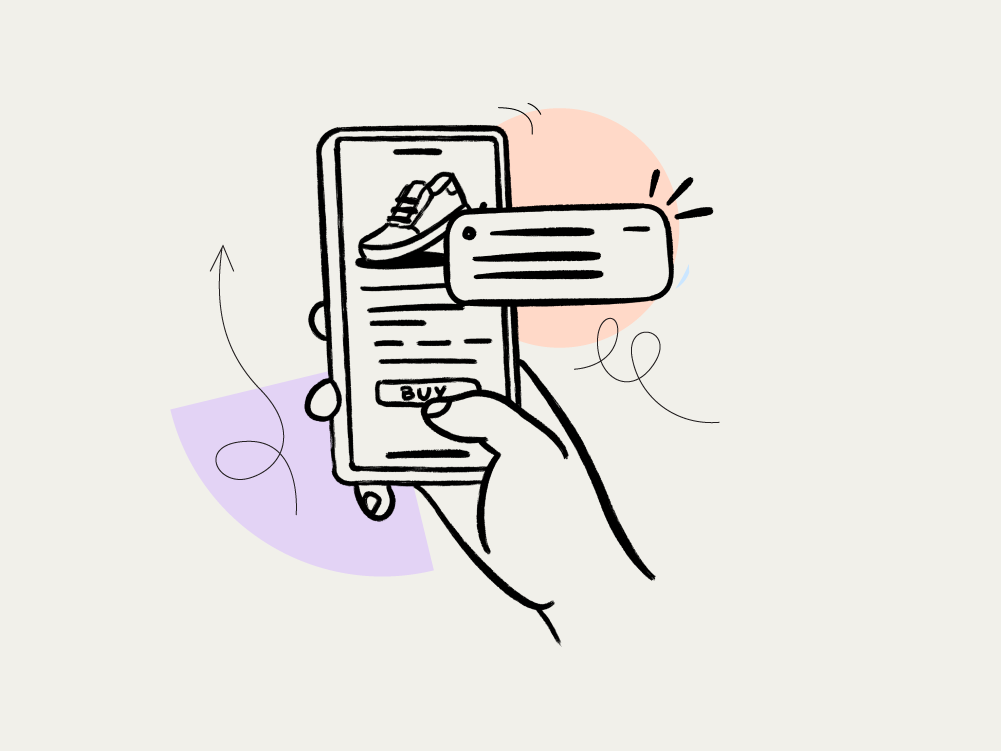Customer retention is a critical aspect of running a successful Shopify business.
A bird in the hand is worth two in the bush - and a customer in your CRM is worth five outside. And that’s a fact.
The cost of acquiring a new customer is five times higher than the cost of retaining an existing one.
And the probability of selling to an existing customer is up to 14 times higher than the probability of selling to a new customer, and existing customers are 50% more likely to try new products and spend 31% more.
A successful business strategy isn’t just about acquiring new customers; it's also about keeping your existing customers engaged and coming back for more.
In this article, we’re going to cover 15 proven strategies to boost your Shopify sales and customer loyalty.

12 Ways to Boost Customer Retention on Shopify
1. Loyalty Programs
27% of customers will spend more with a brand if they’re part of their loyalty program - and 84% of consumers say they’re more likely to stay with a brand that offers a loyalty program.
There are many tools on the Shopify App Store such as YotPo, Stamped, and Smile can help to reward repeat customers with discounts, free gifts, and more.
You can offer points for purchases, referrals, and other actions, which customers can then redeem for exclusive offers unavailable otherwise.
2. Personalized Marketing
It might sound simple, but using customer’s names can help them feel more connected to you, and therefore, less likely to leave.
By sending personalised product recommendations, abandoned cart notifications, and special offers based on a customer's preferences, you’re not only showcasing more of your products but also building a relationship with your customers based on what they like.
3. Email Marketing
One key aspect of personalisation is within your emails - not just with the content you send, but who you send it to.
To create further personalisation, try to create segmented email lists based on customer behaviour and preferences, sending targeted and relevant emails to each customer segment based on their unique features (age, gender, behaviour, etc.).
These could include new product announcements, special promotions, and personalised recommendations.
For example, you may group customers based on demographics, behaviour, or how long they’ve been shopping with you. Old customers don’t need to learn as much about your company as new customers, and they may be used to your main products and benefit from more niche picks.
Using an email marketing tool can streamline this process, helping you efficiently manage segments and deliver highly personalised content.
4. Customer Support
It’s easy to think of customer support as a headache, but it’s absolutely essential to the success of your Shopify store.
Not only can it turn disgruntled customers into happy ones, but it can also provide a comfort blanket for potential new customers. Someone who’s not sure about buying from your store is far more likely going to take a risk if you have highly-rated customer service than if you didn’t.
68% of consumers will pay more for products and services from a brand with a good reputation for customer service - and for 86% of customers, good customer service can turn them from one-time buyers into long-term brand champions.
Always aim to respond promptly to customer inquiries, resolve issues efficiently, and gather feedback where possible. Having public review sites such as Trustpilot can be scary, but it’s also a way for new customers to figure out how reliable you are.
You can read our in-depth guide about how to improve your customer support here.
5. Post-Purchase Follow-up
Anyone who views a purchase as the end of the funnel is guaranteed to have low retention rates. In fact, the post-purchase phase is one of the most crucial aspects of getting repeat customers.
If your customers no longer hear from you after they’ve bought from you, then they’re far less likely to come back again.
53% of customers view the post-purchase period as the most emotional part of any shopping experience.
Think of it this way: let’s say you have a friend who needs to borrow some money. They keep talking to you about how great you are and how much they value you, and because they’re being so nice, you agree to send them some extra funds.
However, once the money’s in their bank account, they stop reaching out to you and become hard to contact.
How are you going to feel about that friend? That’s how your customers can feel when they don't hear from you after their purchase.
Always make sure to follow up with customers to ensure their satisfaction, send a thank-you email, and request any feedback whilst also letting them know how to get in contact with your customer service if they need to.
6. Community Building
Create a sense of community around your brand by encouraging customers to share their experiences online, whilst connecting with your brand through social media, forums, and user-generated content (UGC).
When customers are part of a community, they build an emotional connection with your brand, and emotionally connected customers spend 2x more and have over 300% higher lifetime value compared to non-emotionally connected customers.
7. Subscription Models
Subscription models are an obvious choice for improving customer retention as your customer’s locked into a recurring payment.
You don’t have to offer subscription models for your products. Websites like ASOS now offer a subscription service simply to unlock year-round free next-day shipping. Not only does that give them more predictable revenue, but it also entices customers to choose ASOS over other brands. If you’re already paying money to ASOS every month, why would you buy from a rival brand?
And they readily help customers understand the value.

It’s not expensive - and even at just 2 orders a year, customers are already making a saving.
And customers feel like they have to make the most out of their subscription by placing multiple orders throughout the year.
8. Mobile Experience
79% of traffic to Shopify stores comes from a mobile device, so if you’re only tweaking your desktop site, you’re not optimising for the majority of your audience.
85% of customers prefer to use a mobile app over a mobile website. Why?
- Smoother navigation
- Faster loading times
- More intuitive layout
- Easier shopping experience
- Personalised messaging
And more.
Not to mention, in-app messages are proven to boost retention by 30%.
Improving your mobile experience is a surefire way to skyrocket your customer retention.
The best way to optimise your Shopify store for mobile is to get a Shopify mobile app. Learn why.
9. Retargeting
Retargeting ads are a great way to re-engage an already interested audience.
You can use platforms like Facebook and Google to reach out to previous visitors or customers who didn't complete a purchase, and remind them of your products and promotions.
To give your ads a boost, use an exclusive offer to help your audience feel special. You could offer a percentage discount, free shipping, or gifts to make your audience feel appreciated and connected to your brand.
10. Surveys and Feedback
One of the best ways to improve retention is by listening and acting upon audience feedback.
Feedback could come from surveys, social media comments, review sites like Trustpilot, or direct messages.
If you’re doing something right, do more of it - or shout about it in your marketing collateral. If there’s an area you could improve upon, thank the customer for the feedback and assure them you’ll improve. Show them their opinion matters.
If someone’s unhappy with your services, chances are they’re not the only ones - and that could be putting off customers from returning.
Don’t be too disheartened by negative feedback - everyone gets it - but it’s how you deal with it that differentiates you from the rest.
11. Content Marketing
Content marketing is an excellent way to provide free value to your customers.
You can use blog posts, videos, or free downloads to offer exclusive, genuinely helpful material as a way to improve trust and emotional connection between you and your audience.
Find out how to create an effective content strategy for your Shopify store.
12. Social Proof
Whilst we like to think otherwise, humans act on group mentality - we’re easily influenced by other people’s actions.
By showcasing customer reviews and testimonials prominently on your website and marketing material, you can boost trust and credibility with your customers, enticing them to engage with your brand.
Plus, they’re one of the best forms of UGC to help boost your sales.

Final Thoughts
Customer retention is an ongoing process. Building strong, long-lasting relationships with your customers doesn’t happen overnight.
However, by consistently delivering real value and continually looking for ways to improve your customer experience, you can significantly improve customer retention for your Shopify store, in turn leading to more customers, more sales, and more revenue.
If you want to find out more about how we can improve your retention rates, book a discovery call with one of StoreLab's Shopify growth experts.
Shopify Customer Retention FAQ
How do I retain more customers on Shopify?
The best way to retain more customers on Shopify is to improve their experience.
Look at their full journey and note ways in which it could be improved. Here are the 10 questions to ask yourself if you’re looking to retain more Shopify customers:
- How do customers first find your Shopify store?
- Are they more likely to visit your store on mobile or desktop?
- Is your Shopify store easy to navigate?
- How smooth is the purchase journey?
- How easy is the checkout experience?
- What does their post-purchase experience look like?
- How helpful is your customer service?
- What’s commonly mentioned in your feedback and reviews?
- Do you actively offer value outside of your products?
- Do you look for ways to re-engage customers after they’ve made a purchase?
What is retention rate?
Retention rate refers to the number of customers you retain over a period of time. A 100% customer retention rate would mean you never lose a customer.
For example, if you had 500 customers in January and 500 customers in March, you would have a 100% retention rate. If you had 250 customers in March, you would have a 50% retention rate.
Generally, retention rate is measured over a quarter or annual period.
What is a good customer retention rate on Shopify?
A good customer retention rate depends on your business area
Here are the average retention rates broken down by industry from highest to lowest:
- Media companies: 84%
- Professional services: 84%
- Automotive and transportation: 83%
- Insurance: 83%
- IT services: 81%
- Construction and engineering: 80%
- Financial services: 78%
- Telecom industry: 78%
- Healthcare: 77%
- IT and software industry: 77%
- Banking: 75%
- Consumer services: 67%
- Manufacturing: 67%
- Retail: 63%
- Hospitality, travel, and restaurant: 55%
What impacts customer retention rate on Shopify?
Various factors impact retention rate on Shopify, but here are the main ones:
- Customer experience
- Customer satisfaction
- Brand & product diversity (how different you and your products are from competitors)
- Pricing
- Trust & credibility
What is the average returning customer rate on Shopify?
Though it varies by industry, the average returning customer rate for Shopify stores is 27%.

Skyrocket your Shopify sales with a no-code Apple & Android mobile app. Available now on the Shopify app store.















.webp)
